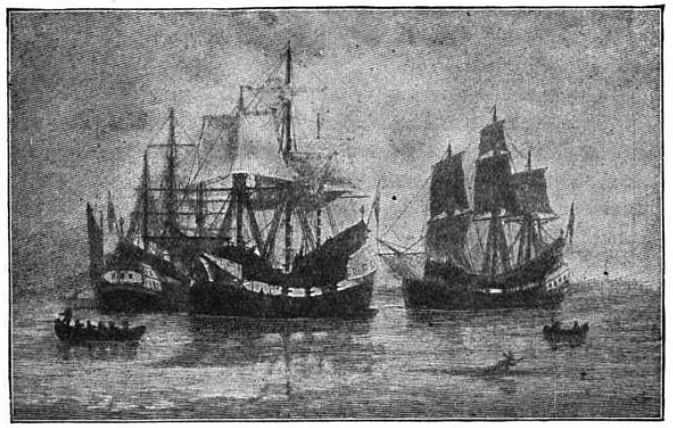 | ||
The Winthrop Fleet was a group of 11 ships led by John Winthrop that carried about 1,000 Puritans plus livestock and provisions from England to New England over the summer of 1630, during the period of the so-called Great Migration.
Contents
Motivation
The Puritan population in England had been growing for several years leading up to this time. The Puritans disagreed with the practices of the Church of England, whose rituals they viewed as superstitions. An associated political movement attempted over many years to modify religious practice in England to conform to their views. King James I wished to suppress this growing rebellious movement. Nevertheless, the Puritans eventually gained a majority in Parliament. James' son Charles came into direct conflict with Parliament, and viewed them as a threat to his authority. He temporarily dissolved parliament in 1626, and again the next year, before dissolving parliament permanently in March 1629. The King's imposition of Personal Rule gave many Puritans a sense of hopelessness regarding their future in that country, and many prepared to leave it permanently for life in New England.
Motivated by these political events, a wealthy group of leaders obtained a Royal Charter in March 1629 for a colony at Massachusetts Bay.
A fleet of five ships had departed a month previously for New England that included approximately 300 colonists, led by Francis Higginson. However, the colony leaders and the bulk of the colonists remained in England for the time being, to plan more thoroughly for the success of the new colony. Later that year, the group who remained in England elected John Winthrop to be Governor of the Fleet and the Colony. Over the ensuing winter, the leaders recruited a large group of Puritan families, representing all manner of skilled labor, to ensure a robust colony.
Voyage
The initial group (Arbella and her three escorts) departed Yarmouth, Isle of Wight on April 8, the remainder following in two or three weeks.
Seven hundred men, women, and children were distributed among the ships of the fleet. The voyage itself was rather uneventful, the direction and speed of the wind being the main topic in Winthrop's journal, as it affected how much progress was made each day. There were a few days of severe weather, and every day was cold. The children were cold and bored, and there is a description of a game played with a rope that helped with both problems. Many were sick during the voyage.
The Winthrop Fleet was a well-planned and financed expedition that formed the nucleus of the Massachusetts Bay Colony. However they were not the first settlers of the area. There was an existing settlement at Salem, started in about 1626, populated by a few hundred Puritans, most of whom had arrived in 1629, and who were governed by John Endicott. Winthrop superseded Endicott as Governor of the Colony upon his arrival in 1630.
The flow of Puritans to New England continued for another ten years, during a period known as the Great Migration.
Ships
Winthrop's journal lists the eleven ships that were in his fleet:
Six other ships arrived at Massachusetts Bay in 1630, for a total of seventeen ships that year.
Notable passengers
Nine leading men both applied for the charter for the Massachusetts Bay Colony and came to New England in Winthrop's Fleet.
Other passengers of historical significance include (in alphabetical order):
A complete list of passengers is maintained by The Winthrop Society, a hereditary organization of descendants of the Winthrop Fleet and later Great Migration ships that arrived before 1634.
